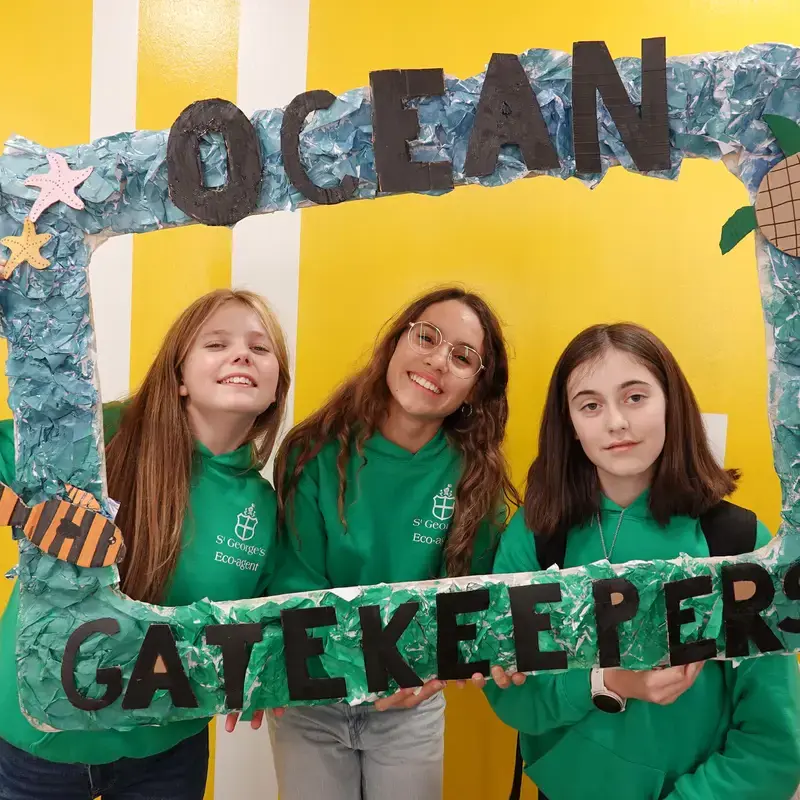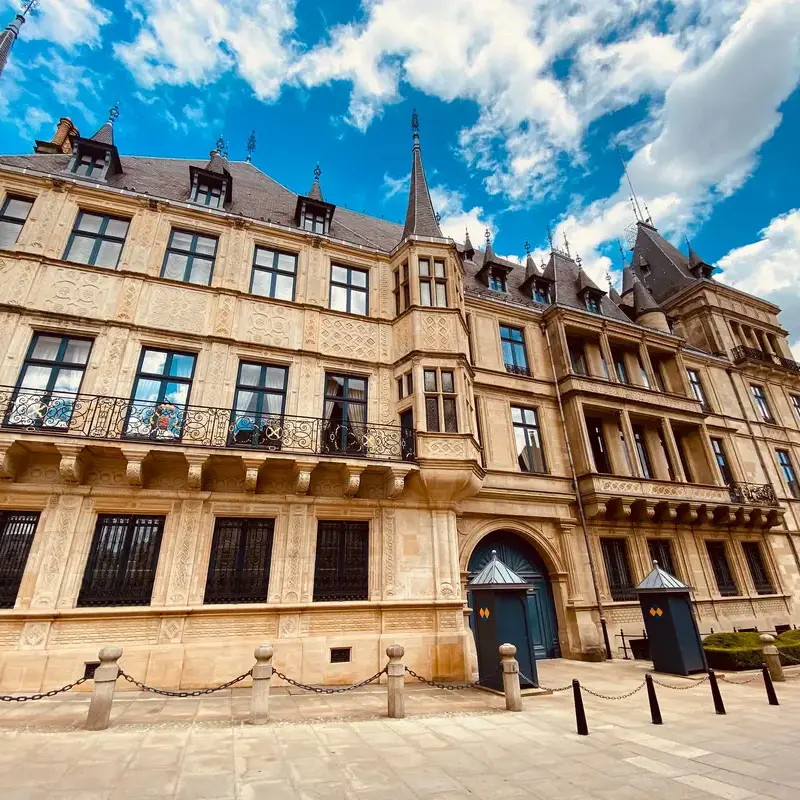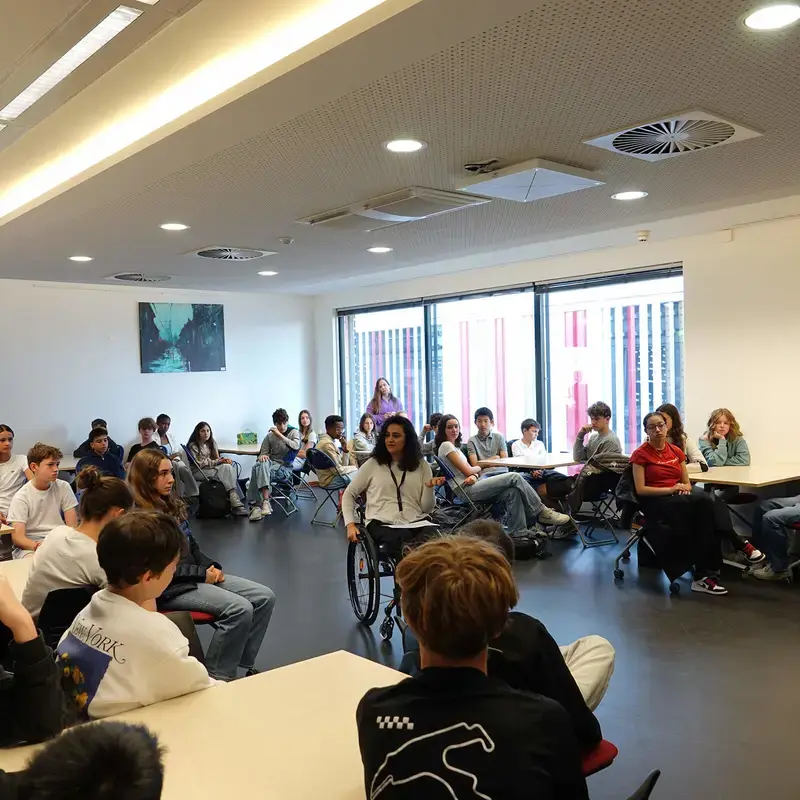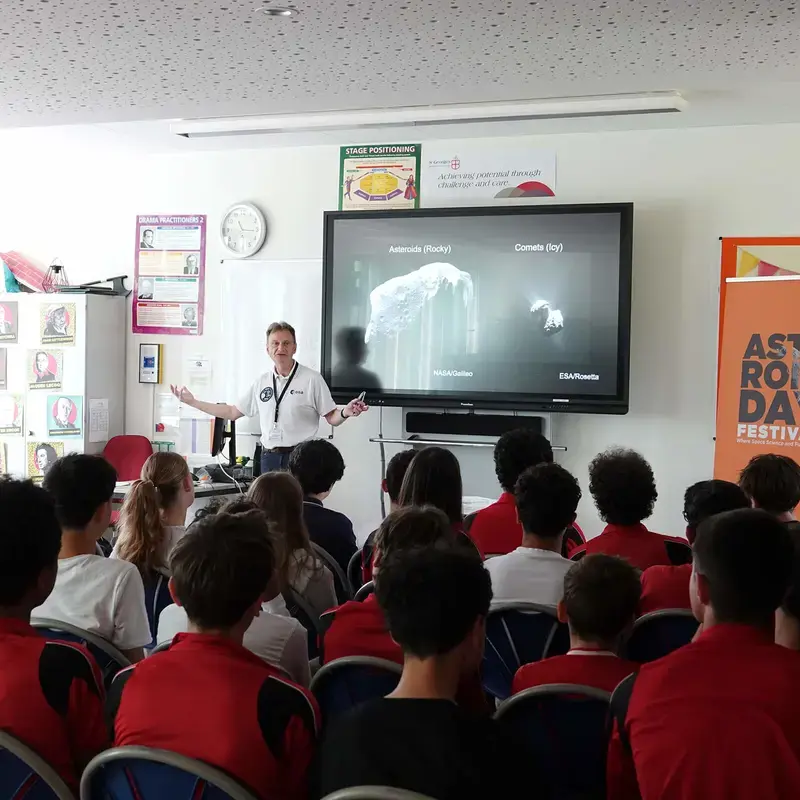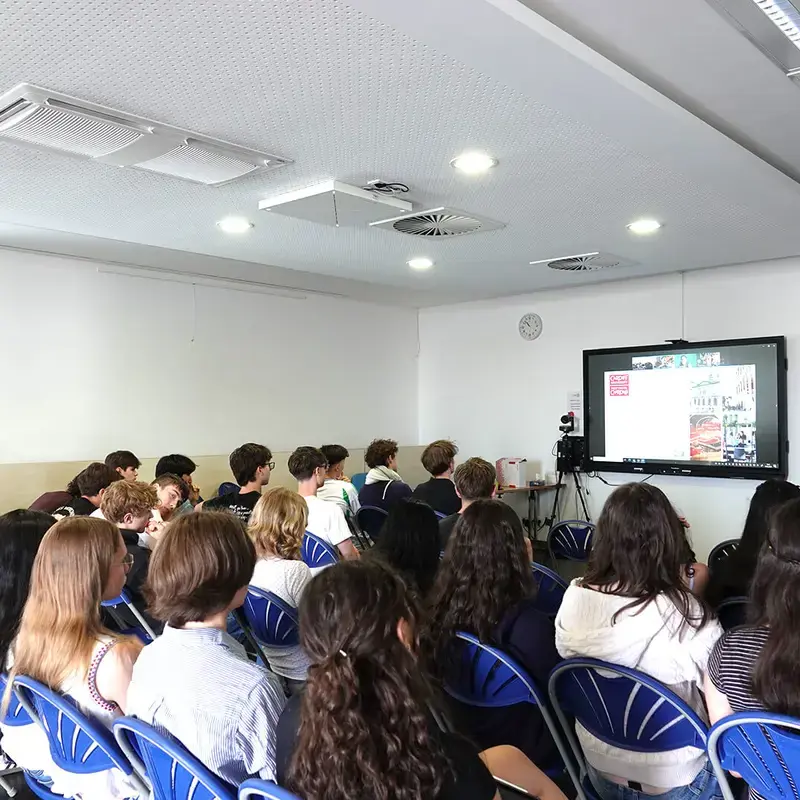HIGHLIGHTS
Latest News
Latest News from St George's
-
Ms Simmonds' festive message 2025
Secondary Headteacher Claire Simmonds reflects on the 2025 festive period at St George's.
-
Ms Nuttall's 2025 Christmas message
St George's Primary Headteacher and Vice-Principal Claire Nuttall reflects on the magic of working in a primary school at Christmas time.
-
Shoebox Appeal spreads festive joy
More than 200 students and staff joined forces on Monday, 15 December, to collect and sort 400 donated gift packs as part of the St George's Christmas Shoebox Appeal.
-
Inside Luxembourg: The Christmas period
Inside Luxembourg with Isabelle Frisch-Koopmans this week looks at Christmas traditions, from family meals to fireworks and the sharing of the Dräikinnekskuch.
-
Inside Luxembourg: Christmas Markets
Inside Luxembourg with Isabelle Frisch-Koopmans this week looks at the Christmas markets in Luxembourg City and surrounding towns and villages.
-
David Walliams visits St George's
Renowned British children’s author and comedian David Walliams delighted students with a fun and interactive show at St George’s International School, Luxembourg on 4 December 2025.
-
Soup disco nourishes
Year 9 students joined St George's canteen staff to cook vegetable soup for Le Courage Café, a social bistro that provides free meals, showers and laundry for people without stable housing.
-
Big weekend of rugby against Frankfurt
St George's participated in its first block rugby fixture at Under 14, Under 16 and Under 18 level against Frankfurt International School.
-
Inside Luxembourg: Tradition of Kleeschen
Inside Luxembourg with Isabelle Frisch-Koopmans looks at the special tradition of Kleeschen, Luxembourg's St Nicholas.
-
Exploring autumn in the forest
Reception students explored the forest on 21 November 2025, taking note of the seasonal autumn changes and building confidence through a challenging activity.
-
Students shine at COBIS conference
St George’s students showed exceptional maturity and insight in their contributions to this year’s COBIS Conference on Belonging and Inclusion, attended by more than 150 international school leaders and professionals.
-
Year 4 underground adventure
A visit to Musée National des Mines in Luxembourg brought learning to life for students studying Earth’s natural resources in Year 4 science and humanities classes.
-
Journey to Ancient Egypt for Year 3
Year 3 students will journey back in time to Ancient Egypt this half-term to explore how the natural world – the sun, land and river – shaped one of the earliest civilisations
-
Ocean documentary inspires student action
More than 150 people attended a screening of Ocean with David Attenborough and the launch of a new sustainability project at St George’s.
-
Inside Luxembourg: Advent traditions
Inside Luxembourg with Isabelle Frisch-Koopmans this week looks at the Grand Duchy's Advent traditions in the weeks leading up to Christmas.
-
Inside Luxembourg: Through the lens
Inside Luxembourg with Isabelle Frisch-Koopmans this week explores the work of Edward Steichen (1879–1973), one of the most influential photographers of the 20th century and a pioneer who shaped both the artistic and social role of photography.
-
Inside Luxembourg: Walfer Bicherdeeg 2025
Inside Luxembourg with Isabelle Frisch-Koopmans this week looks at the popular book fair Walfer Bicherdeeg, which runs from 15 to 16 November 2025.
-
Inside Luxembourg: All Saints and All Souls days
Inside Luxembourg with Isabelle Frisch-Koopmans this week looks at the traditions of All Saints and All Souls days, which are times to remember and honour those who came before us.
-
Inside Luxembourg: Trauliicht
Inside Luxembourg with Isabelle Frisch-Koopmans this week looks at the Hunnefeier festival in Schengen every October that marks the end of the grape harvest.
-
Inside Luxembourg: Hunnefeier in Schengen
Inside Luxembourg with Isabelle Frisch-Koopmans this week looks at the Hunnefeier festival in Schengen every October that marks the end of the grape harvest.
-
Year 4 celebrates Viking Day
Year 4 students deepened their understanding of Viking life through a range of creative and engaging activities on Friday, 10 October.
-
Inside Luxembourg: The Veiner Nëssmoort
Inside Luxembourg with Isabelle Frisch-Koopmans this week looks at autumn in the Grand Duchy and some of the enchanting walks suitable for children.
-
Year 4 trade market brings history to life
Year 4 students stepped back in time to experience the bustling world of early medieval trade as part of an exciting humanities topic on the Vikings.
-
Inside Luxembourg: Autumn magic
Inside Luxembourg with Isabelle Frisch-Koopmans this week looks at autumn in the Grand Duchy and some of the enchanting walks suitable for children.
-
Inside Luxembourg: The Throne Change
Inside Luxembourg with Isabelle Frisch-Koopmans this week looks at the significance and celebration of the changing of the throne.
-
Year 5 poetry slam
Year 5 students took to the stage for a poetry slam, showcasing their creative talents inspired by the book Escape from Pompeii and their studies on the Ancient Romans.
-
Year 4 oral health talk
St George's new sports season kickstarted with a bang on Saturday, 6 September, as our rugby teams took on Walferdange at both Under 14 and Under 16 level.
-
St George's makes Under 9 cricket debut
St George's new sports season kickstarted with a bang on Saturday, 6 September, as our rugby teams took on Walferdange at both Under 14 and Under 16 level.
-
BTEC students put through paces
St George's new sports season kickstarted with a bang on Saturday, 6 September, as our rugby teams took on Walferdange at both Under 14 and Under 16 level.
-
Inside Luxembourg: A taste of September
Inside Luxembourg with Isabelle Frisch-Koopmans this week looks at the flavours of September – grapes and plums.
-
New sports season begins
St George's new sports season kickstarted with a bang on Saturday, 6 September, as our rugby teams took on Walferdange at both Under 14 and Under 16 level.
-
Inside Luxembourg Schueberfouer
Inside Luxembourg with Isabelle Frisch-Koopmans this week looks at the Schueberfouer and its staple dish Fouerfësch.
-
Students pursue passions over summer
St George's ran five Summer Schools in holidays, giving students the chance to gain skills in arts and crafts, basketball, painting, acting, and songwriting and production.
-
Students produce excellent exam results in 2025
Almost half of St George's class of 2025 achieved the highest possible gradings in their final exams.
-
Eco-Agents rewild the campus
St George's Primary and Secondary Eco-Agents participated in a campus rewilding project, working with UNature to rethink concrete spaces.
-
Economics served up for breakfast
Two Sixth Form economics students and their teacher Julia van Kalles attended a roundtable breakfast event with HSBC's Global Chief Economist Janet Henry and HSBC Global Head of Political Risk Dr Helen Belopolsky at the British Ambassador's Residence on Thursday, 9 May.
-
Symmetry, strategy and Swiss chocolate
Four Year 6 students represented St George's at the ECIS Maths Quest competition, hosted by Ecolint School in Geneva, from 9 to 11 May.
-
Girls dominate in 7-0 football victory
St George's Primary girls and boys football teams faced off against International School Michel Lucius on Tuesday, 6 May. The girls gave an impressive demonstration of skill, determination and teamwork in their commanding 7-0 victory.
-
Students hear firsthand account of war experience
If you had to leave your house overnight, what object would you take with you and why? That was the first question presented to Year 8 students by Marwa Almbaed, an activist for the rights of people with disabilities.
-
Energy and attitude shine in rugby matches
St George's boys and girls rugby teams have been gaining experience and skills at exhibition matches and tournaments in Luxembourg and further afield.
-
Merite Jeunesse Gold practice expeditions held
Four St George's Gold Mérite Jeunesse participants embarked on a cycling journey across Luxembourg from 3 to 6 April.
-
Space workshop out of this world
Year 10 students attended a SpaceConnectsUs Workshop on Thursday, 26 June, with an astronomer and physics student.
-
Ms Simmonds' 2025 end-of-year highlights
St George's Secondary Headteacher Claire Simmonds shares her memorable moments from the 2024-2025 academic year.
-
Ms Nuttall's 2025 end-of-year highlights
St George's Primary Headteacher and Vice-Principal Claire Nuttall shares her memorable moments from 2025.
-
Students discuss cybersecurity on radio
St George's media students Sara, Mila and Elena – who present the B122 Show on Radio Ara every second and fourth Wednesday of the month – recently spoke to Aya Tharwat, an expert on cybersecurity.
-
St George's fields three teams in Il Piccolo Mondo football tournament
St George's entered three teams in this year's Il Piccolo Mondo football tournament hosted by Luxembourg City Football Club on Saturday, 21 June.
-
St George's becomes a Fairtrade School
St George’s is taking steps to ensure a fairer, more sustainable world by becoming a Fairtrade School in collaboration with Fairtrade Lëtzebuerg.
-
Ms O Doherty a finalist in Teacher of Year Awards
St George's Primary teacher Síghle O'Doherty is one of three finalists in the Pearson International School Teacher of the Year Awards. She was selected from 250 shortlisted candidates, which also included her colleague Mary Davis.
-
Art Exhibition 2025 gallery
St George's Art Exhibition 2025 was a vibrant display of creative works from students across all year groups. A particular highlight was the work of GCSE and A-level students.
-
Hundreds attend Summer Fayre 2025
More than 700 people attended St George's Summer Fayre 2025, enjoying the family-friendly activities, food from around the world and the chance to catch up with friends from the school and local community.
-
Celebrating National Day with science
To celebrate National Day on 23rd June, Year 8 science students used their knowledge of density to create the Luxembourg's flag in a beaker.
-
Students introduced to Year 13
Year 12 students took part in a two-day induction programme on 16 and 17 June to help them transition smoothly into their final year of school and begin preparing for university applications.















